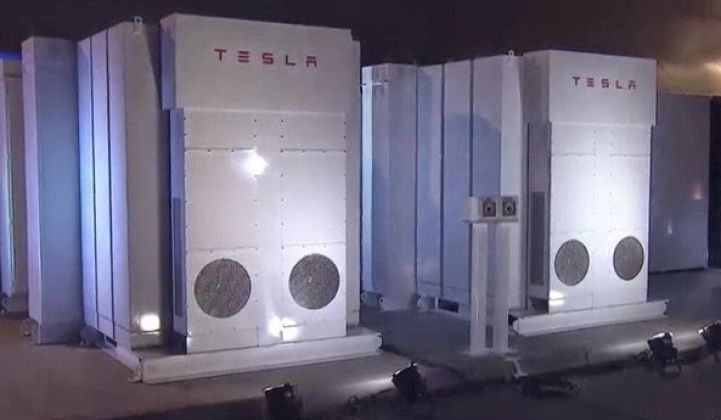Tesla’s ambitious 100-megawatt, 129-megawatt-hour battery project in South Australia has garnered plenty of interest for being the largest project of its kind in the world. But the company doesn't seem to have a business plan, according to Australian energy experts.
"There's no genuine business case for storage in Australia at the moment, and no genuine business case for the Tesla project,” said Dr. Jill Cainey, global applications director for energy storage at S&C Electric in Melbourne.
“The technical requirements -- that is, the role the battery will have on the system -- were not well described or understood" when the tender for the battery project was issued, she said.
This has left Cainey and others wondering how the project will make money.
At an Australian Clean Energy Summit presentation given in Sydney this month, Advisian Principal Consultant Bruce Miller outlined several ways a hypothetical large-scale battery plant might make money in South Australia. Few of them seemed to apply to Tesla’s project.
The potential applications for storage include time-shifting power, frequency control ancillary services (FCAS), voltage control and reactive power, backup supplies, black starts, modifying marginal and distribution loss factors, grid upgrade deferrals and network stabilization.
In practice, though, not all these are money-makers where Tesla and project partner Neoen are planning to develop their plant.
Network upgrade deferral, for example, might be a big reason to install a battery system in many markets, but in South Australia there is no need because electricity demand is forecast to fall.
In fact, in Miller’s analysis only four value streams emerged as potential revenue generators.
He calculated that a battery system with 10 megawatts and 20 megawatt-hours of capacity, linked to a wind farm, might be able to pull in AUD $2.8 million (USD $2.2 million) a year from power trading and AUD $2.6 million (USD $2.1 million) a year from supplying backup energy.
The plant could also make around AUD $700,000 (USD $554,000) from loss factor modification (helping to overcome grid losses), and a paltry AUD $50,000 (USD $40,000) a year from FCAS.
That latter figure might come as a surprise to energy storage project developers in other parts of the world, where ancillary services are crucial to a battery plant’s business case.
But in Australia, Cainey said, the FCAS market does not properly value speed of response.
On top of this, she said, the Australian Energy Market Operator dispatch system requires batteries to offer 10 generation and 10 load bids for each out of a potential eight FCAS offerings, in every 30-minute settlement period.
Because the dispatch system treats batteries as separate generation and load assets, battery operators must frame their FCAS bids carefully to avoid having to export and import energy at the same time.
Even taking FCAS income out of the picture, though, Miller’s analysis suggests a battery system could still make money in Australia. So why can’t Tesla’s?
The issue is duration.
With an 80-minute discharge time, the Tesla project is far from the 10-megawatt, 20-megawatt-hour capacity Miller envisaged. And that cuts off even more revenue options.
Of all those listed by Miller, Cainey said the Tesla project would only really be able to deliver network stabilization services. In her view, the whole basis for the project was political, rather than technical or financial.
“The project is politically driven by the South Australian government, which needs to demonstrate that [it is] working to resolve the issues that led to the Black Grid of September 2016 and the load shedding of summer 2016-2017," she said.
Despite this, the September 2016 blackouts forced policy changes that may provide a lifeline to projects like Tesla’s in the future.
“A raft of potential new requirements, some close at hand, some further way, will require a range of system support services, such as inertia, frequency support and rate-of-change-of-frequency management,” said Cainey.
“This means that renewable generators are going to have to find ways of providing support. That may be batteries…but synchronous condensers are also favored."
Tesla declined to answer questions regarding the business case for the battery project.
In a July blog post, the company simply said the project “will help solve power shortages, reduce intermittencies, and manage summertime peak load to improve the reliability of South Australia's electrical infrastructure.”



